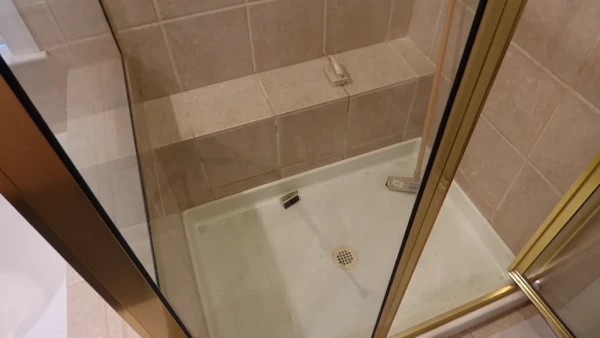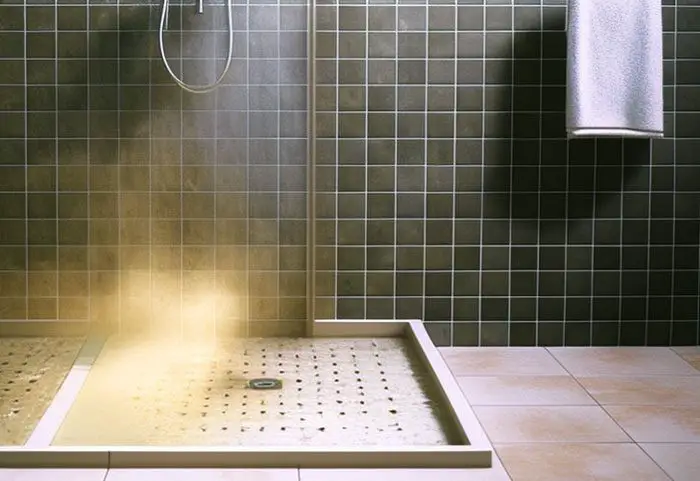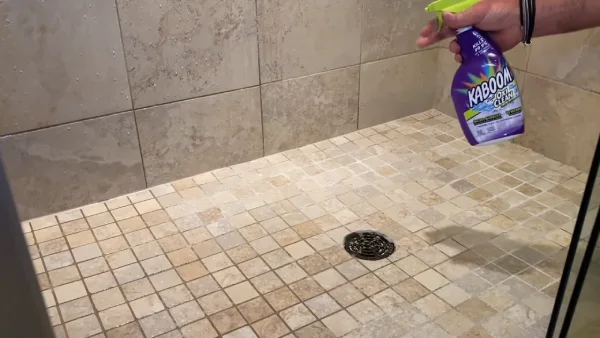Last Updated on November 14, 2023
Stepping into your shower should be a calming, sanitary experience. But if grout mold is putting up a fight against good hygiene, many turn to using toilet bowl cleaners for the job. However, can it handle shower room surfaces, or is it safe to use toilet bowl cleaner in the shower?
There’s a misconception that products designed for the toilet won’t work in other areas of the shower room. The truth is, this isn’t always the case. When cleaning surfaces in the shower, a toilet bowl cleaner is definitely a good choice.
You can make your shower sparkle with the proper steps & precautions while avoiding dangerous chemical cleaners. We’ll explore how to safely use toilet bowl cleaner in a shower and effectively clean tiles without harsh chemicals.
Is it Safe to Use Toilet Bowl Cleaner in Shower Grout Mold?

When removing shower grout mold, you can trust a toilet bowl cleaner (such as Clorox toilet bowl cleaner). From mild acids to specially formulated abrasives, these cleaners are equipped with all the ingredients to remove burdensome and persistent stains from showers.
But keep in mind that the concentration of any acid or abrasive should not be too high, as this could cause damage to the surface of the grout or other shower surfaces of the shower room. This means that you must read and adhere strictly to any instructions on the packaging when using a toilet bowl & bathroom cleaner.
To keep your stained shower area looking pristine, apply a bit of toilet bowl cleaner directly to the surface and let it sit for around 5 minutes. Afterward, use a scrub brush or sponge to remove any grime before giving everything one last rinse with warm water.
For a completely clean, rinse the mold-affected area with warm water to eliminate any last traces of debris. Then, use paper towels or an old rag to ensure it’s thoroughly dry once finished.
Also, double-check for anything you may have overlooked in previous steps. Feel free to repeat everything until your spotless and shining result is achieved.
Is Toilet Bowl Cleaner Safe for Shower Tiles?
Toilet bowl cleaner is generally safe for shower tile. The active ingredient in most toilet cleaners is hydrochloric acid, a mild acid. This acid can remove stains, mildew, and soap scum from the surface of tiles.
But don’t use these cleaners on aluminum or stainless steel shower surfaces because the acid may harm them. If you use a toilet bowl cleaner on tiles in the shower, ensure you rinse the area afterward.

When using toilet bowl cleaner to clean shower tiles, it is best to pre-treat the affected areas with a gentle detergent before applying the product. This will help reduce any adverse effects of using a strong chemical cleaner like hydrochloric acid.
After pre-treating, apply the toilet bowl cleaner directly onto the affected areas and let sit for several minutes before scrubbing away any stubborn dirt or grime.
How Do You Clean Shower Tiles With Toilet Bowl Cleaner?

Toilet bowl cleaners effectively remove shower tile dirt and soap scum because they contain hydrochloric acid, which dissolves dirt, grime, and soap scum quickly and effectively. Here’s how you clean shower tiles using toilet bowl cleaner:
Introduction:
Step 1: Gather the Supplies Needed
Gathering together the correct supplies for this activity is essential for success. You will need the following:
- Rubber gloves to protect your hands
- A scrub brush
- Toilet bowl cleaner
Be sure to check the label on the bottle to determine if additional supplies are needed or if there are any particular safety guidelines to follow.
Step 2: Prepare the Shower Area
The next step is preparing your work area. Remove all washcloths and other items within reach of where you’ll be applying the cleaner, so they do not get damaged by exposure to its components. Turn off any fans or other ventilation systems so that fumes do not spread throughout your home while the cleaner sits on your tiles.
Step 3: Mix up Cleaning Solution
Now comes the time to mix up your cleaning solution according to the manufacturer’s instructions listed on their product label.
To begin cleansing shower tiling with toilet bowl cleaner, mix a solution by combining one part water and one part toilet bowl cleaner (recommended by most manufacturers) in an appropriate container.
Make sure you mix it correctly as instructed; otherwise, it could cause discoloration in certain materials. It’s also essential to wear protective gloves during this step, as contact with concentrated chemicals can cause irritation or burns when in direct contact with the skin for prolonged periods.
Step 4: Spread the Cleaning Solution
Once mixed, begin by spreading out an even coat of the solution onto all desired areas of the surface that require cleaning by using either a spray bottle or rag/sponge, depending on what toilet bowl cleaner you purchased for use in this task.

Allow it to sit for five minutes before proceeding further. Ensure to stay within 15 minutes, as leaving it on longer than necessary could also lead to potential deterioration if not washed off properly after use.
Step 5: Scrub All Desired Areas
After the clock strikes five minutes, whip out that trusty brush or sponge and get scrubbing. Make sure to remove dirt or debris from all surfaces and crevices gently. No need for too much pressure, a gentle hand will do just fine. That way, you’ll keep your grout lines intact and sparkling clean.
Step 6: Rinse the Areas Thoroughly
When you’ve scrubbed and soaped the desired areas to perfection, give them a good rinse with some warm water. Set yourself up using a spray bottle or cloth/sponge (whichever you used for your initial cleaning application).
After you’ve rinsed thoroughly, ensure all suds have been cleared away. Then give it a few minutes of air-drying before moving on.
Are There Any Safety Risks of Using Toilet Bowl Cleaner in a Shower?

Cleaning the shower using a toilet bowl cleaner is essential to a bathroom hygiene routine. Here’s what you need to know about the safety risks of using a toilet bowl and bathroom cleaner in a shower:
1. Potential Health Hazards
The most crucial factor to consider when using any kind of cleaner in the shower is the potential health hazards posed by exposure to toxic chemicals.
Most toilet bowl cleaners contain chlorine bleach or other harsh chemicals that can cause skin irritation and respiratory problems if they are inhaled or absorbed through the skin.
If you choose to use a toilet bowl cleaner in the shower, use it sparingly and wear protective gear such as gloves and eye protection when handling it.
2. Damaging Surfaces
Another potential danger of using a toilet bowl cleaner in a shower is that it may damage surfaces such as marble or tile if used too often or left on for extended periods. The acidity within the cleaners can slowly degrade surfaces over time, leading to discoloration, cracking, or fading.
It’s best to test an inconspicuous area before applying any cleaning product on larger surfaces and periodically monitor areas for signs of damage due to prolonged exposure.
3. Corroding Plumbing Fixtures
Regular use of strong chemical cleaners can cause corrosion to your metal fixtures like faucets, drains, and pipes over time.
As such, metal fixtures should be monitored regularly for signs of corrosion and replaced immediately if any damage is detected due to their critical role. Be sure to dilute these products with water before application.
4. Damage to Septic Systems:
Many traditional toilet bowl cleaners contain active ingredients such as chlorine which can damage septic systems over time if used too frequently. Thus it is essential to consider how often you use these products if you are connected to a septic system or a cesspit.
5. Ineffective Performance on Heavily-Soiled Surfaces:
With regular toilet bowl cleaners, light stains won’t stand a chance, but you may need to break out the big guns for stricter buildup, like soap scum or rust deposits from hard water. Think abrasive scrubbing pads and special shower/bathroom chemical-based removers.
Does Toilet Bowl Cleaner Damage Shower Plumbing?

Toilet bowl cleaner may damage shower plastic plumbing materials if it is not used correctly. The ingredients in many modern toilet bowl cleaners are strong enough to break down the plastic materials found in plumbing pipes over time, especially if left for an extended period.
This can lead to cracks in the pipes which can lead to leaks and other water damage if not treated properly. For this reason, toilet bowl cleaners should be used only on hard surfaces such as porcelain tiles or enamel basins, avoiding direct contact with plastic shower plumbing wherever possible.
What Should You Not Clean in Your Shower with Toilet Bowl Cleaner?
It is generally not recommended to use it on soft fabrics such as curtains or shower mats, as they may become discolored by this harsh chemical compound and can also cause skin irritation if contacted directly.
With its powerful ingredients, this product shouldn’t be used on glass doors or mirrors as they might suffer scratches and damage. Don’t use toilet bowl cleaner in a sink if it is made of harsh chemicals. Furthermore, do not mix toilet bowl cleaner with other household cleaning products, as this could produce toxic fumes that are hazardous to health when inhaled directly.

Keep Your Shower Sparkling: Use Toilet Bowl Cleaner Carefully
Toilet bowl cleaner can be an excellent product for tackling mold, grout, and tile cleaning. But if you’re thinking of taking it into your shower for a longer time, think again. Long-term use can cause significant damage, so take caution with this potentially hazardous household chemical.
To stay safe while cleaning your shower with toilet cleaner, take all the necessary precautions, like wearing gloves to limit contact with cleaners and avoiding mixing different products. Mixing ill-advised concoctions can create hazardous gas or residue that could harm or damage your shower surfaces.
Keep your shower looking spotless and germ-free with quality toilet bowl cleaners. Don’t let mold and mildew sneak in between the grout. Eliminate them quickly, safely, and effectively.


